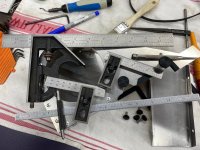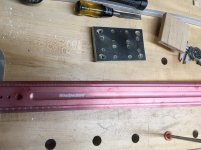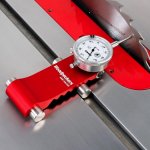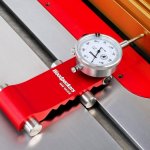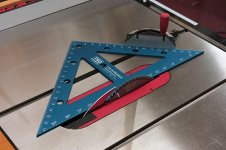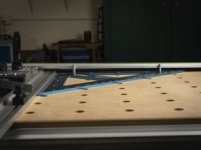I’m setting up my new sliding table saw and want to get a good square. What size would you recommend? Brand? I’m looking at this one:https://taytools.com/collections/to...kinex-knife-edge-inspection-machinist-squares
You are using an out of date browser. It may not display this or other websites correctly.
You should upgrade or use an alternative browser.
You should upgrade or use an alternative browser.
Looking for a good square
- Thread starter Bird
- Start date
ryanjg117
Member
- Joined
- May 18, 2015
- Messages
- 329
That square could work, however I'm not sure the knife edge would be helpful for this application. Why not go with a combination square? What are you trying to measure with precision here?
I've had good results with a small square, a combination square, and a Wixey style angle finder.
I've had good results with a small square, a combination square, and a Wixey style angle finder.
I see you are looking at "Machinists Squares". I agree with that because in metalworking, tolerances are typically much tighter than in woodworking and tools are correspondingly more accurate.
Even a relatively cheap machinist's square will be pretty darn accurate.
Those look like good tolerances, although I would want slightly larger square.
Its nice having a couple of squares you KNOW are accurate.
If you want more choices, try a metalworking site, such as KBC Tools.
Even a relatively cheap machinist's square will be pretty darn accurate.
Those look like good tolerances, although I would want slightly larger square.
Its nice having a couple of squares you KNOW are accurate.
If you want more choices, try a metalworking site, such as KBC Tools.
If you take a piece of plywood about 2 foot square and cut about half an inch of each side rotating the plywood in one direction the finished off cut should be exactly half an inch at both sides.
If the fence is off the discrepancy will be magnified x4 on the final cut.
If the fence is off the discrepancy will be magnified x4 on the final cut.
Crazyraceguy
Member
- Joined
- Oct 16, 2015
- Messages
- 4,908
Second on the 1-2-3 blocks. They are very handy as squares and as spacers.
Machinist squares are a bit overkill but not really over the top either. Mid-level or even lower end are plenty accurate enough for use on table saws, jointer fences, etc.
As Steve1 said, pretty much all machinist tools are far more accurate than woodworking tools need to be.
Machinist squares are a bit overkill but not really over the top either. Mid-level or even lower end are plenty accurate enough for use on table saws, jointer fences, etc.
As Steve1 said, pretty much all machinist tools are far more accurate than woodworking tools need to be.
When your setting up your New Slider A Dial indicator is almost a must to make it the Best you can quickly and Accurately.
Look at the One Way Multi gauge (https://oneway.ca/products-category/miscellaneous/Multi-Gauge) for setting the Slider Toe Out , Rip Fence Toe out and the Slider height from the Cast Top. You will also need a Good straight edge and a Good level. There is a Good series from David Best on Instagram if you Google that name along with setting up your sliding table saw it will walk you right through it from start to finish. Beware It takes a lot of Patience ...
Look at the One Way Multi gauge (https://oneway.ca/products-category/miscellaneous/Multi-Gauge) for setting the Slider Toe Out , Rip Fence Toe out and the Slider height from the Cast Top. You will also need a Good straight edge and a Good level. There is a Good series from David Best on Instagram if you Google that name along with setting up your sliding table saw it will walk you right through it from start to finish. Beware It takes a lot of Patience ...
- Joined
- Jun 25, 2016
- Messages
- 624
[member=64135]Bird[/member] - congrats on having the space for a Slider!
Your set up tools can serve you multiple other tasks for a very long time - so this may be a place where you want to buy for the long haul.
You may not be aware of two precision squaring tools we have been making for several years. Inspired by customers who were frustrated that they could not buy a precision 18 inch Square/Triangle when it was available only as a red anodized One Time Tool.
So we chose to fill that need with a competitively priced tool TSO PTR-18 that had a few extra features:https://tsoproducts.com/tso-precision-system-triangles/
It was not long before other features were also requested leading to TSO's family of Precision Triangles and accessories:
- the TSO MTR-18 Multi Function Triangle.
enjoying some quality time in our woodshop this holiday week, I'm sure glad to have both of these tools available along with my trusty STARRETT Combination Square, Digital Caliper, 1-2-3 Blocks and more.
Happy New Year in your woodshop [smile]
Hans
Your set up tools can serve you multiple other tasks for a very long time - so this may be a place where you want to buy for the long haul.
You may not be aware of two precision squaring tools we have been making for several years. Inspired by customers who were frustrated that they could not buy a precision 18 inch Square/Triangle when it was available only as a red anodized One Time Tool.
So we chose to fill that need with a competitively priced tool TSO PTR-18 that had a few extra features:https://tsoproducts.com/tso-precision-system-triangles/
It was not long before other features were also requested leading to TSO's family of Precision Triangles and accessories:
- the TSO MTR-18 Multi Function Triangle.
enjoying some quality time in our woodshop this holiday week, I'm sure glad to have both of these tools available along with my trusty STARRETT Combination Square, Digital Caliper, 1-2-3 Blocks and more.
Happy New Year in your woodshop [smile]
Hans
For setting things up I have never used a square and can't think why it would be needed. Two dial indicators and a one way surface gauge is what I use and David best shows some innovative ways to use them. The first thing I did when I got mine was turn it on and use it and for some years I never had any issues with the machine's accuracy. There seems to be a fetish out there for fiddling with these machines when they don't need it and I can state emphatically that the first time setting the table heights requires a fair bit of head scratching to understand what is going on with the adjustments available. As an aside if an accurate square is needed order good quality plastic geometric triangle, they are as accurate as any square offered here or anywhere else for all practical purposes.
Cheese
Member
- Joined
- Jan 16, 2015
- Messages
- 12,509
For any initial eye-balling my go-to tool is a Starrett combination square. Sometimes a 12" or sometimes a 4" depending upon the task. This gives you a baseline for most measurements and helps you to decide what other measurement tools or methods you'll need to set up the tool/jig/fixture.
[attachimg=1]
I'd anticipate that a 4' long straight edge would also be helpful.
[attachimg=2]
In addition, a dial indicator would be useful especially this Woodpeckers version for setting the fence parallel to the saw blade in a conventional saw setup.
[attachimg=3]
[attachimg=4]
Finally, I have also used the large TSO triangle because of the 18" length of each leg and it is capable of lying flat on a machine surface.
[attachimg=5]
[attachimg=6]
[attachimg=1]
I'd anticipate that a 4' long straight edge would also be helpful.
[attachimg=2]
In addition, a dial indicator would be useful especially this Woodpeckers version for setting the fence parallel to the saw blade in a conventional saw setup.
[attachimg=3]
[attachimg=4]
Finally, I have also used the large TSO triangle because of the 18" length of each leg and it is capable of lying flat on a machine surface.
[attachimg=5]
[attachimg=6]
Attachments
John P Clark
Member
- Joined
- Sep 9, 2010
- Messages
- 6
Try Lamb tools - great for squaring up fences on sliders
https://lambtoolworks.com/square
https://lambtoolworks.com/square
Cheese said:For any initial eye-balling my go-to tool is a Starrett combination square. Sometimes a 12" or sometimes a 4" depending upon the task. This gives you a baseline for most measurements and helps you to decide what other measurement tools or methods you'll need to set up the tool/jig/fixture.
[attachimg=1]
Is that on a slider? I will still back the plastic against the fanciest squares for the purposes discussed here and spend the saved money elsewhere. Mind you I wold not touch any slider without proof that it had a problem, it is a rabbit hole which is best not entered until it is necessary to do so. Some of the tools Cheese shows will not even work on some sliders.
I'd anticipate that a 4' long straight edge would also be helpful.
[attachimg=2]
In addition, a dial indicator would be useful especially this Woodpeckers version for setting the fence parallel to the saw blade in a conventional saw setup.
[attachimg=3]
[attachimg=4]
Finally, I have also used the large TSO triangle because of the 18" length of each leg and it is capable of lying flat on a machine surface.
[attachimg=5]
[attachimg=6]
Sparktrician
Member
- Joined
- Dec 4, 2009
- Messages
- 4,607
That Woodpeckers Saw Gauge is really great for testing if there's any run-out on a saw blade, and if so, how much. [smile]
Sparktrician said:That Woodpeckers Saw Gauge is really great for testing if there's any run-out on a saw blade, and if so, how much. [smile]
Some sliders which we are referring to here do not have a slot in the table so it can't be used or at least in the manner that was intended by WP. Setting up the table runout is another job that can be fraught with frustration as well because it interferes with the table height. The sliding table on these saws are set above the cast iron table and the runout is needed to avoid cutting on the back of the blade. Forget everything you ever knew about cabinet saws as it does not apply.
Shinwa has an excellent reputation for their measuring tools. Their carpenters' square it smallish, in stainless steel, and just $11.00 from Amazon.com. I would give that a try first. It is graduated in metric. So be aware of that.
https://www.amazon.com/SHINWA-CARPENTERS-SQUARE-30CM-stainless/dp/B007MUO8K4
They also make a mini-carpenters' square but I don't know where to buy it: https://www.fine-tools.com/mini-framingsquares.html
https://www.amazon.com/SHINWA-CARPENTERS-SQUARE-30CM-stainless/dp/B007MUO8K4
They also make a mini-carpenters' square but I don't know where to buy it: https://www.fine-tools.com/mini-framingsquares.html
Sparktrician
Member
- Joined
- Dec 4, 2009
- Messages
- 4,607
Packard said:Shinwa has an excellent reputation for their measuring tools. Their carpenters' square it smallish, in stainless steel, and just $11.00 from Amazon.com. I would give that a try first. It is graduated in metric. So be aware of that.
https://www.amazon.com/SHINWA-CARPENTERS-SQUARE-30CM-stainless/dp/B007MUO8K4
They also make a mini-carpenters' square but I don't know where to buy it: https://www.fine-tools.com/mini-framingsquares.html
The mini square is also on Amazon.
Cheese
Member
- Joined
- Jan 16, 2015
- Messages
- 12,509
Mini Me said:Is that on a slider? I will still back the plastic against the fanciest squares for the purposes discussed here and spend the saved money elsewhere. Mind you I wold not touch any slider without proof that it had a problem, it is a rabbit hole which is best not entered until it is necessary to do so. Some of the tools Cheese shows will not even work on some sliders.
Well, understand that I approach this type of work from a machinist perspective as I arrived at woodworking from a machinist background, so my approach is going to be different than a woodworkers approach....hopefully the end results will be similar.
The tools shown was just a photo that I already had and I just wanted to be clear for the poster what a combination square was.
My perspective is the same as yours, from a metal working/machinist view. The accuracy of the plastic geometric squares is as phenominal and not well known. The durability of them is obviously a problem and they would never survive in a tool room.
Similar threads
- Replies
- 0
- Views
- 330
- Replies
- 0
- Views
- 752
- Replies
- 0
- Views
- 236
- Replies
- 0
- Views
- 748

